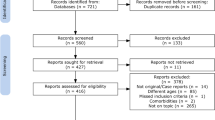Abstract
The subjects were parents, siblings, and children of schizophrenic patients. Auditory evoked potentials (EPs) (P300) were recorded in the standard oddball paradigm with a probability of the target stimuli presentation of 0.2 and sound (tone) intensity of 60 dB. A comparison of these data with the results of the examination of reference groups (normal subjects free of a family history of mental pathology) showed significantly longer latent periods of N1, N2, and P3 in EPs to target stimuli in siblings and children of schizophrenic patients, as well as significantly decreased amplitudes of N1 and P2 in EPs to nontarget (standard) stimuli and longer latent periods of N2 in EPs to target stimuli in the parents of schizophrenic patients.
Similar content being viewed by others
REFERENCES
Gnezditskii, V.V., Vyzvannye potentsialy mozga v klinicheskoi praktike (Evoked Brain Potentials in Clinical Practice), Taganrog: Taganrogsk. Gos. Radiotekhn. Univ., 1997.
McCarley, R., O'Donnell, B., Niznikiewicz, M., et al., Update on Electrophysiology in Schizophrenia, Int. Rev. Psychiatry, 1997, vol. 9, p. 373.
Hegerl, U., Event-Related Potentials in Psychiatry, in Electroencephalography: Basic Principles, Clinical Applications, and Related Fields, Niedermeyer, E. and Lopez da Silva, F., Eds., Williams & Wilkins, Waverly, 1999, 4th ed., p. 621.
Naatanen, R. and Picton, T., The N1 Wave of the Human Electric and Magnetic Response to Sound: A Review and an Analysis of the Component Structure, Psychophysiology, 1987, vol. 24, no. 4, p. 375.
Ivanitskii, A.M., Strelets, V.B., and Korsakov, I.A., Informatsionnye protsessy mozga i psikhicheskaya deyatel'nost' (Cerebral Information Processes and Mental Activity), Moscow: Nauka, 1984.
Kanunikov, I.E. and Vetosheva, V.I., Modern Concepts of the Psychophysiological Significance of P300, Fiziol. Chel., 1988, vol. 14, no. 2, p. 314.
Polich, J., P300 in Clinical Applications: Meaning, Method, and Measurement, Am. J. EEG Technol., 1991, vol. 31, p. 201.
Kostandov, E.A., Zakharova, N.N., Reshchikova, T.N., and Chak”rov, V.E., Impairment of the Information Selection Mechanism in Schizophrenic Patients, Zh. Nevropatol. Psikhiat., 1993, vol. 93, no. 4, p. 55.
Lebedeva, I.S., Orlova, V.A., Kaleda, V.G., and Tsutsul'kovskaya, M.Ya., P300 of Auditory Evoked Potentials in Schizophrenia, Zh. Nevropatol. Psikhiat., 2000, vol. 100, no. 11, p. 47.
Kutcher, S., Blackwood, D., St. Clair, D., et al., Auditory P300 in Borderline Personality Disorder and Schizophrenia, Arch. Gen. Psychiatry, 1987, vol. 44, no. 7, p. 645.
Ogura, C., Nageishi, Y., Matsubayashi, M., et al., Abnormalities in Event-Related Potentials, N100, P200, P300 and Slow Wave in Schizophrenia, Jpn. J. Psychiatry Neurol., 1991, vol. 45, no. 1, p. 57.
Friedman, D. and Squires-Wheeler, E., Event-Related Potentials (ERPs) as Indicators of Risk for Schizophrenia, Schizophrenia Bull., 1994, vol. 20, no. 1, p. 63.
Kidogami, Y., Yoneda, H., Asaba, H., and Sakai, T., P300 in First Degree Relatives of Schizophrenic Patients, Schizophrenia Res., 1991, vol. 6, no. 1, p. 9.
Kimble, M., Lyons, N., O'Donnell, B., et al., The Effect of Family Status and Schizotypy on Electrophysiologic Measures of Attention and Semantic Processing, Biol. Psychiatry, 2000, vol. 47, no. 5, p. 402.
Turetsky, B., Cannon, T., and Gur, R., P300 Subcomponent Abnormalities in Schizophrenia: III. Deficits in Unaffected Siblings of Schizophrenic Probands, Biol. Psychiatry, 2000, vol. 47 no. 5, p. 380.
Schreiber, H., Stolz-Born, G., Rothmeier, J., et al., Endogenous Event-Related Brain Potentials and Psychometric Performance in Children at High Risk for Schizophrenia, Biol. Psychiatry, 1991, vol. 30, no. 2, p. 177.
Karoumi, B., Laurent, A., Rosenfeld, F., et al., Alteration of Event-Related Potentials in Siblings Discordant for Schizophrenia, Schizophrenia Res., 2000, vol. 41, no. 2, p. 325.
Blackwood, D., St. Clair, D., Muir, W., and Duffy, J., Auditory P300 and Eye Tracking Dysfunction in Schizo-phrenic Pedigrees, Arch. Gen. Psychiatry, 1991, vol. 48, no. 10, p. 899.
Frangou, S., Sharma, T., Alarcon, G., et al., The Maudsley Family Study: II. Endogenous Event-Related Potentials in Familial Schizophrenia, Schizophrenia Res., 1997, vol. 23, no. 1, p. 45.
Roxborough, T., Muir, W., Blackwood, D., et al., Neuropsychological and P300 Abnormalities in Schizophrenic Patients and Their Relatives, Psychol. Med., 1993, vol. 23, no. 2, p. 305.
Polich, J., P300 in Clinical Application, in Electroencephalography: Basic Principles, Clinical Applications, and Related Fields, Niedermeyer, E. and Lopez da Silva, F., Eds., Williams & Wilkins, Waverly, 1999, 4th ed., p. 1073.
Waldo, M., Adler, L., and Freedman, R., Defects in Auditory Sensory Gating and Their Apparent Compensation in Relatives of Schizophrenic Patients, Schizophrenia Res., 1988, vol. 1, p. 19.
Michalewski, H., Prasher, D., and Starr, A., Latency Variability and Temporal Interrelationships of the Auditory Event-Related Potentials (N1, P2, N2, and P3) in Normal Subjects, Electroenceph. Clin. Neurophysiol., 1986, vol. 65, no. 1, p. 59.
Hirayasu, Y., Asato, N., Ohta, H., et al., Abnormalities of Auditory Event-Related Potentials in Schizophrenia Prior to Treatment, Biol. Psychiatry, 1998, vol. 43, p. 244.
Muir, W., St. Clair, D., and Blackwood, D., Long-Latency Auditory Event-Related Potentials in Schizophrenia and in Bipolar and Unipolar Affective Disorder, Psychol. Med., 1991, vol. 21, no. 4, p. 867.
O'Donnell, B., Hokama, H., McCarley, R., et al., Auditory ERPs to Non-Target Stimuli in Schizophrenia: Relationship to Probability, Task-Demands, and Target ERPs, Int. J. Psychophysiol., 1994, vol. 17, p. 219.
Lebedeva, I.S., Orlova, V.A., and Savina, T.D., P300 in the Families of Schizophrenic Patients, Am. J. Med. Genetics, 1998, vol. 81, no. 6, p. 496.
Naatanen, R. and Picton, T., N2 and Automatic vs Controlled Processes, in Cerebral Psychophysiology: Studies in Event-related Potentials (EEG Suppl. 38), McCallum, W., Zappoli, R., and Denoth, F., Eds., New York: Elsevier, 1986, p. 169.
Author information
Authors and Affiliations
Rights and permissions
About this article
Cite this article
Lebedeva, I.S., Orlova, V.A. Features of Auditory P300 in Relatives of Schizophrenic Patients. Human Physiology 27, 289–293 (2001). https://doi.org/10.1023/A:1010961603716
Issue Date:
DOI: https://doi.org/10.1023/A:1010961603716




